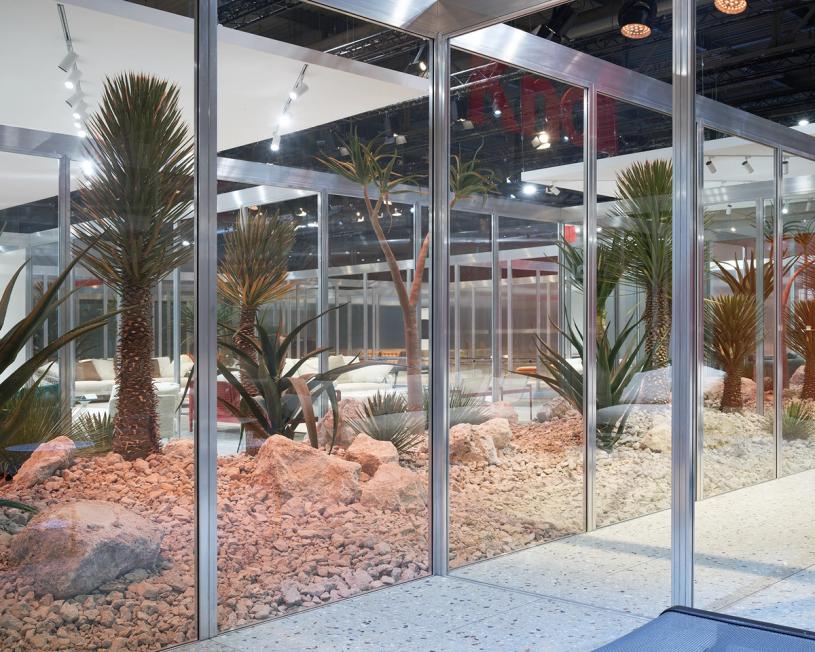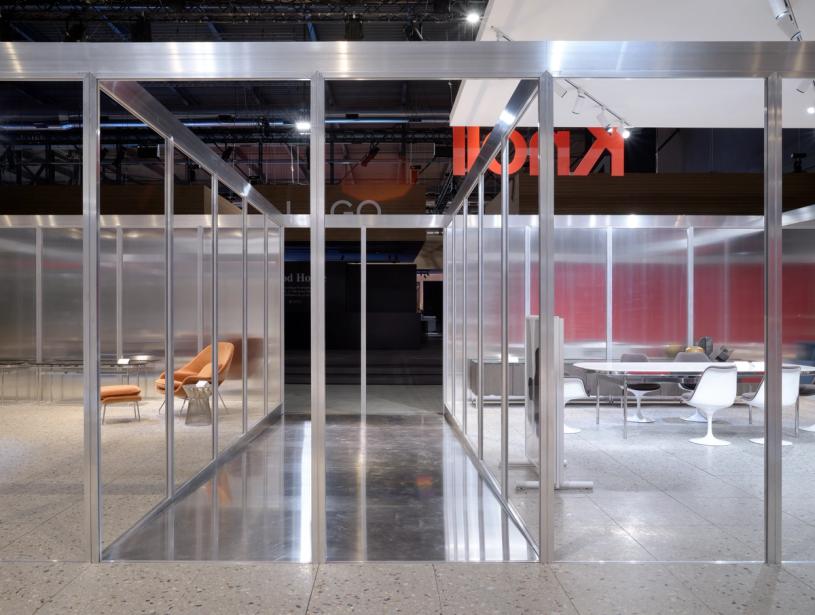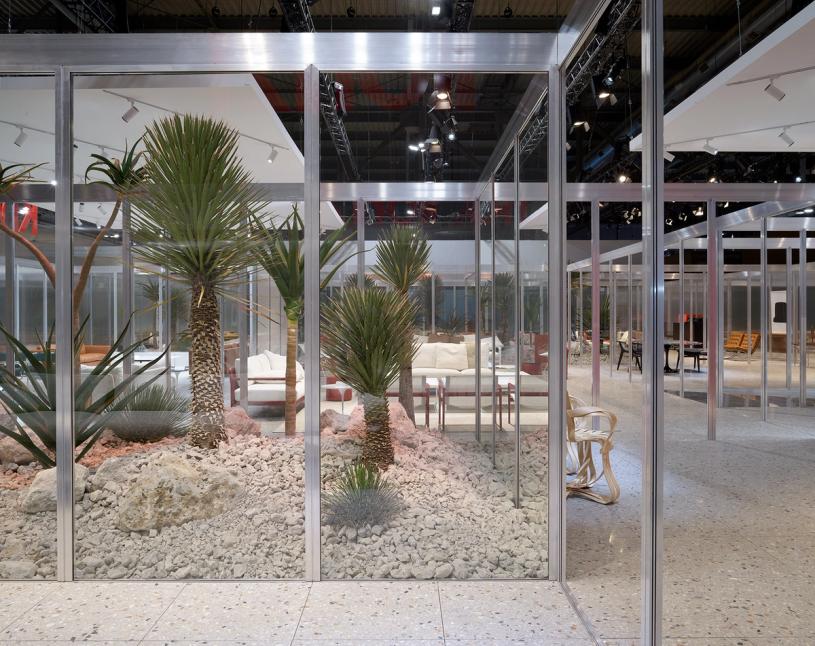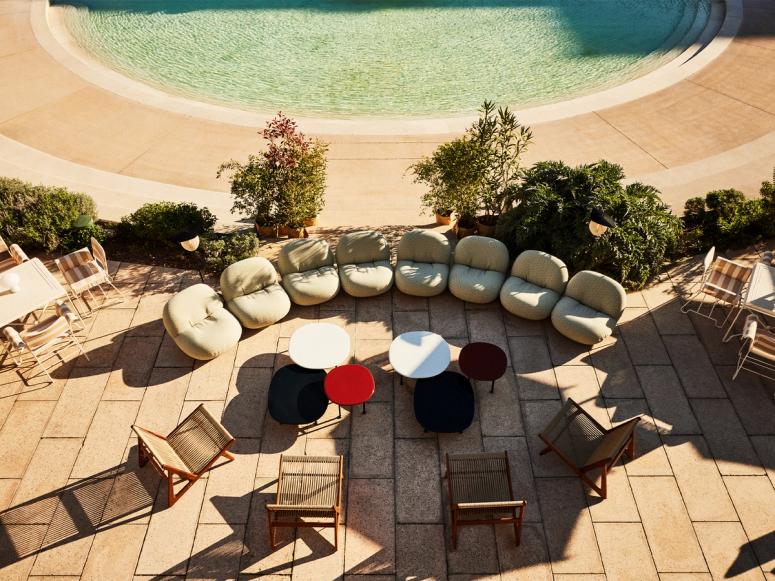
Everywhere I went during this year’s Milan Design Week, there seemed to be a palpable feeling that the Salone del Mobile design and furniture fair, now in its 61st year, is sputtering, or, at the very least, puttering. While it unquestionably remains the world’s most important annual design event, it was evident that the winds are increasingly blowing toward the Fuori Salone, or “Outside Salone,” presentations and events around the city—particularly the buzzy independent design fair Alcova, which this year took place at a former slaughterhouse, and spaces in and around the city’s Brera neighborhood, long a Milan Design Week stronghold. Going forward, I expect more design brands, eschewing the notion of a “booth” and pursuing more experiential (and, let’s hope, more sustainable) approaches to presenting their wares, to take over atypical environments such as the Bagni Misteriosi, a pool from the 1930s where the Danish design brand GUBI presented its latest collections this year, or the Bonacossa Tennis Club, where the Milan-based designer Cristina Celestino created a pop-up restaurant with the food collective We Are Ona. Many architects, designers, and journalists I spoke with skipped the Rho fairgrounds altogether this year, preferring to stick to the city’s happenings. They, too, noted the fair’s growing sense of irrelevance, if in hushed tones.
Salone is quite literally losing ground: The 2023 edition of the fair was streamlined to be on one level instead of two at the 42-acre fairgrounds, a move that was promoted for sustainability reasons, but that also obviously stemmed from practical business matters. This year, there were 1,962 exhibitors, down from 2,418 in 2019. And though the fair was back to its regular April dates—following Covid closures that led to a mini edition in September 2021 and a decidedly slimmed-down iteration last June—the event was no return to business as usual. For many brands participating, there was a clear desire to return to a pre-Covid sense of “normal,” but across the five hours I walked the fairgrounds last week, it was evident that, emerging out of the pandemic, Salone, as with the world around it, has changed forever. Long beheld as the tentpole of Milan Design Week, Salone is still an impressive behemoth, with more than 300,000 attendees this year, but it no longer has the magnetic pull it once did.
Aside from a handful of standout booths—especially Knoll and Flos—there wasn’t much at Salone that surprised me or stopped me in my tracks. So many of the new designs presented there seemed derivative and staid, or even, in some cases, rushed. Given the timeframe between last June’s edition to this April’s, this wasn’t necessarily surprising. And while the fair did have some degree of curation, including an exhibition by the Swiss-French architectural photographer Hélène Binet and its Salone Satellite presentation of work by designers 35 and under, now in its 35th year and still overseen by the peerless Marva Griffin, it was largely lacking in terms of cultural depth.
I think now is a good time to question the need for an annual fair. While Salone is a vital industry organ and a key economic driver for the city of Milan, why does it need to take place every year? Why must brands build booths again and again, only to tear them down after a week, and too often fail to reuse, recycle, or upcycle their materials? Why not turn Salone into an every-other-year occasion, biennial-style, and tighten its curation and focus—make it an experience? Does simply producing more stuff actually equal more sales growth? I’m not convinced. As a (or even the) centerpiece of the industry, Salone has the power to shift global design conversations, highlight best practices, and even redefine the meaning and purpose of a fair. “Fewer, better things” should be its mantra. Practicing true sustainability would be to produce less, and without a reliance on virgin materials. The fair should be considering this as part of its business model and ethos.
In the manifesto for “Take It or Leave It,” the exhibition and lottery The Slowdown organized with Paola Navone in Milan’s Zona Tortona neighborhood this year (at which nearly 600 numbered objects collected or designed by Navone were given away across five days), we argued that designers will no longer serve the role they have throughout much of the 20th and early 21st centuries. “Designers will need to embrace regenerative resources and nonstandard materials,” the manifesto reads. “Upcycling, recycling, and reuse won’t just be should-dos; they’ll be musts.” The same, I believe, goes for Salone and other design fairs.
The American furniture company Knoll appears to have gotten the memo. Turning the notion of a fair booth on its head, it presented a refreshingly pragmatic model and way forward: a transportable pavilion made out of 50 percent recycled materials, designed by the Belgian architects Kersten Geers and David Van Severen. Built out of aluminum posts and beams, glass panels, and a recycled concrete terrazzo floor, it was the company’s first major effort under designer Jonathan Olivares, who joined Knoll as senior vice president last year. “It’s an architectural project,” he told me of the structure, which is more befitting of Palm Springs than any convention hall. “When I’ve run into my friends this week, I’ve said, ‘You have to come see the house.’ I haven’t said, ‘You have to come see the furniture’—or, god forbid, ‘the booth.’ That’s derogatory.” Noting that this year was his first time back at the fairgrounds in around a decade, he said, “Yes, there’s furniture here, but Knoll is not a furniture brand. It makes works that are in dialogue with architecture. ‘Furniture,’ at this point, is an overused word. These are works.”
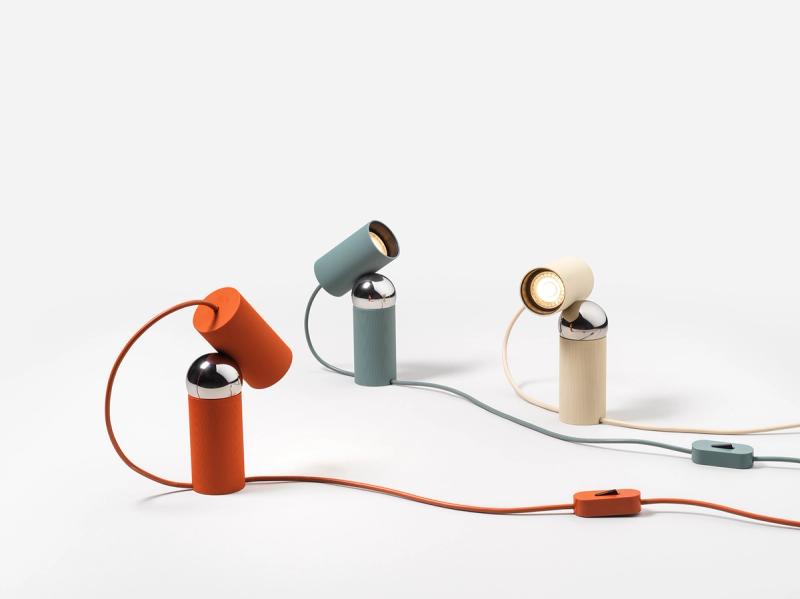
Exiting Knoll, I realized that that was exactly what I was longing for at this year’s fair, and that was largely lacking: not furniture, but works, or what Anders Byriel, the CEO of the Danish textile company Kvadrat, recently described to me on our Time Sensitive podcast as designs with an “artistic edge.” At the booth of the Italian lighting brand Flos, there were new pieces from Konstantin Grcic, Ronan and Erwan Bouroullec, and Philippe Malouin that embodied this sensibility. With its retro-style design, based on vintage cars, and magnetic ball joint, Malouin’s Bilboquet adjustable table lamp especially stood out. The world may not need another lamp, but Bilboquet makes a strong case for adding at least just one more. The rest of the fair mostly felt conventional, snoozy, and status-quo. Visiting Knoll and Flos made it worth the trip.
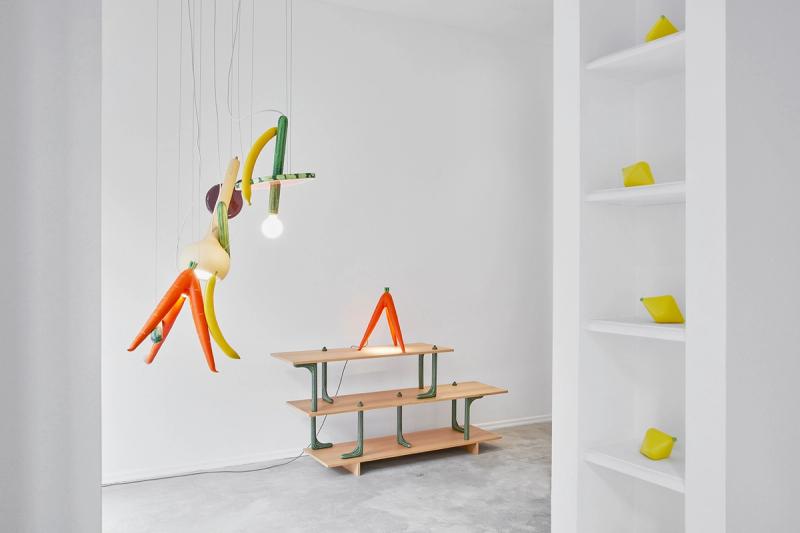
Around the city, a few moments of joy and wonder took hold, and not just at “Take It or Leave It,” where the lottery participants came and went with beaming smiles. At a pop-up space on Via Zenale, Carwan Gallery presented Paris-based designer Robert Stadler’s whimsical OMG-GMO series of ceramic hand-painted objects and furniture from the Italian company Bitossi, several of which first debuted last year at Philip Johnson’s Glass House in New Canaan, Connecticut (where I spent a most perfect afternoon with Stadler as he finished installing the show). The pieces, which humorously nod to both emoji culture and the absurdity of modern-day farming practices, include shelves supported by L-shaped zucchinis, a tripod lamp comprising three oversized interconnecting carrots, and a glass-topped coffee table supported by eggplant wheels. Not just a cheeky exercise, OMG-GMO was two years in the making and rigorously executed. As with all of Stadler’s work, it’s shrewdly rooted in art history and design references.

Inside the Istituto Marcelline Tommaseo, a school and nunnery near the Triennale Design Museum, the design venture AMO—newly formed by Ambra Medda, a founder of Design Miami, and Veronica Sommaruga, a textile expert who has worked with the likes of Calvin Klein and Hermès—presented its debut project, Teatro Albers, in collaboration with the Josef & Anni Albers Foundation. There, Medda and Sommaruga curated a selection of works by designer Marco Compardo and master weaver Laura de Cesare that reference the Alberses’ approaches to seeing and making (Compardo, who created a series of resin benches, looked to Josef’s 1963 book Interaction of Color; de Cesare reinterpreted Anni’s textile techniques). On Sunday evening, at a dinner inside the school (which Medda and Sommaruga both attended in their youth)—during which several of the nuns were present—Nicholas Fox Weber, the Albers Foundation’s longtime director, said that the project was, as with the Alberses’ work, “about experimentation, understanding the process, not imitation,” practically summing up the spirit of what has, I believe, long made Milan Design Week a potent moment for presenting innovation, experimentation, and craft. Through its subtle installation in a special setting, Teatro Albers was Milan Design Week at its best: thoughtful, contextual, beautiful, rigorous, forward-looking, exquisitely-presented, craft-oriented.

Elsewhere, the prankster artist-designer couple Laura Baldassari and Alberto Biagetti of Atelier Biagetti—with their wry work, sometimes it’s hard to tell exactly what the joke is, or if it’s even a joke in the first place—presented “The King,” an Elvis Presley–themed exhibition. The centerpiece was a massive deep-red seating concept that Biagetti told me is intended to turn your living room into a stage. Casually sitting on the sofa in a white leather sequin outfit, in Marina Abramović–style performance mode, was Baldassari, who sang an opera rendition of Presley’s 1961 hit song “Can’t Help Falling in Love.” (In addition to being an artist and designer, she is a trained opera singer.) On the walls were paintings she had made that subtly and satirically reference Graceland. In an industry that far too often takes itself too seriously, Baldassari and Biagetti always inject some humor (past projects have delved into bodybuilding, sex, money, and cats), and this year, perhaps their campiest act yet, was no exception.
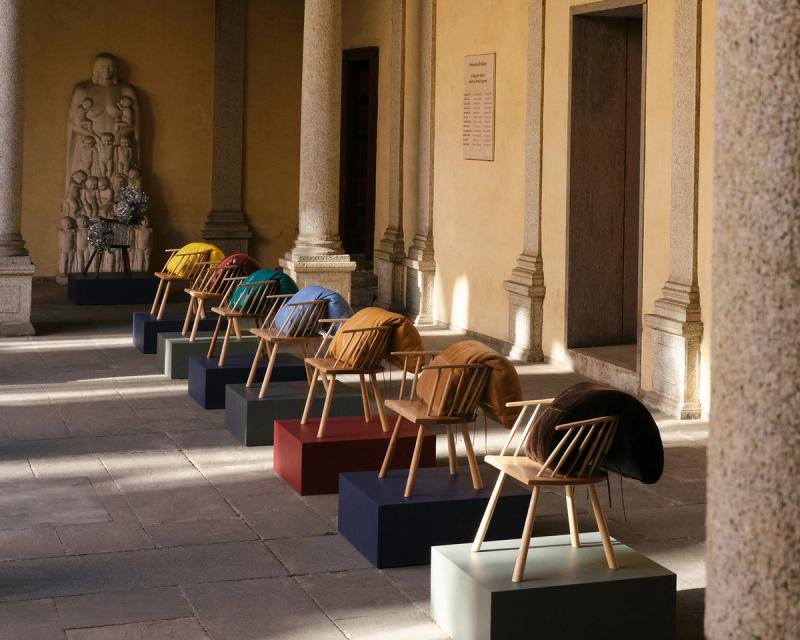
Other highlights of the week for me included Kvadrat, which debuted fabrics by the French designer Ronan Bouroullec that translated several of his drawings into textile form; the Spanish luxury house Loewe, which at the 16th-century Palazzo Isimbardi showcased a playful collection of chairs reimagined by artisans who adorned them with materials such as metallic foils and leather; Lexus, which presented a mobile installation of Noguchi-esque forms from architect Suchi Reddy (alongside work by the winners of the 2023 Lexus Design Award, now in its tenth year); and Google, which under the direction of its visionary vice president of hardware design, the neuroaesthetics expert Ivy Ross, presented “Shaped by Water,” an exhibition conceived with Los Angeles–based artist Lachlan Turczan and emphasizing a subject near and dear to Ross’s heart: vibration.
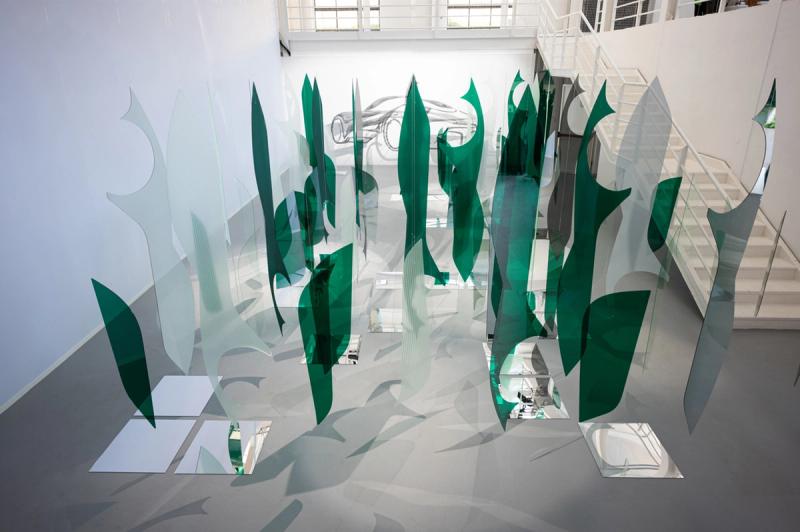
If ever there were a metaphor for what Salone del Mobile and Milan Design Week need a bit more of, vibration is exactly it. The echoes that reverberate out from the fair literally shape the world, and have done so for more than half a century. I wasn’t feeling a whole lot of vibration this year. At least there were a few bright spots.
Keep reading
A prominent figure in the world of qigong; meditation; and neijia, or internal martial arts (she is a sixth generation lineage holder in the Baguazhang practice), Mimi Kuo-Deemer has a Qigong and the Tai Chi Axis: Nourishing Practices for Body, Mind, and Spirit (2019) and Xiu Yang: The Ancient Chinese Art of Self-Cultivation for a Healthier, Happier, More Balanced Life (2020) have served as guides for countless individuals seeking the transformative power of these disciplines. Originally from
All too often, gifts that bring initial delight end their lives in dusty corners, attic nooks, or worse still, the dump.used for years or even decades to come.
This past June, The Slowdown launched our Book of the Month newsletter, for which, at the start of every month, we revieNot Too Late to Tracy K. Smith’s urgent yet timeless memoir To Free the Captives, here are the books we thought fit the bill.
Lara Gilmore lives by the Italian adage festina lente, or, “make haste slowly.” “I interpret it as: Do things, and don’t stop doing them; keep moving forward,” she says. “Bu
Family. Memory. Legacy. These words, these themes, build upon each other. Within our families there are shared moments, To Free the Captives: A Plea for the American Soul (Knopf), the former U.S. poet laureate Tracy K. Smith examines the deepest of American wounds through her own family. Th
Emilia Terragni has a palpable zest for books, food, and design—and for books about food and design. As associate publisher and editorial director of Phaidon’s titles on these subjects, she is a driving f
I find essay collections captivating because they offer the opportunity to dive in at any point. Of course, reading themOpen Questions: Thirty Years of Writing About Art (Phaidon) by Helen Molesworth, the first-ever collection of her art writing, I did in fact start from the beginning.
The Austrian-born, New York–based graphic designer Stefan Sagmeister has a rare knack for tackling broad, universal subjNow Is Better, just out from Phaidon, he’s taken on the subject of long-term thinking, arguing that never before in human history havbetter. First started in the 2020 lockdown, the project vividly brings statistics to life through a range of media, including
Philosopher William B. Irvine’s journey from a youth spent in mining towns in Montana and Nevada to becoming a renowned A Guide to the Good Life: The Ancient Art of Stoic Joy (2007), Aha!: The Moments of Insight that Shape Our World (2014), and most recently, The Stoic Challenge: A Philosopher's Guide to Becoming Tougher, Calmer, and More Resilient (2019). Though he no longer gives classroom lectures, he continues to spread his wisdom through his writing, which aims
Until February 4, 2024, the Brooklyn Museum will have an (unofficial) new name: the Crooklyn Museum. As of last weekend, the fifth floor is hosting “Spike Lee: Creative Sources,” an immersive exhibition featuring more than 450 objects—ranging from artwork, sports jerseys, and film posters to pho
When it comes to astute and unvarnished observations about pressing issues of our time, Roxane Gay never fails to deliveNew York Times contributing opinion writer has gained international recognition for her sharp, subversive output across genres, includDifficult Women (2017); her novel An Untamed State (2014); her memoir, Hunger (2017); and her New York Times best-selling essay collection, Bad Feminist (2014). As is evident across her writing, Gay has a rare knack for both exposing raw truths of the society we live in aThe Sacrifice of Darkness (2020) and the comic book series and Marvel spin-off World of Wakanda (2016-2017)—providing imaginative havens to escape to.
Just over a decade ago, in 2012, Jhumpa Lahiri moved with her husband and two children to Rome. In the 12 years prior, sInterpreter of Maladies; her best-selling 2003 novel, The Namesake, was turned into a Hollywood film directed by Mira Nair. Her arrival in Rome, it turned out, would alter her already exThe Lowland, which was a finalist for both the Man Booker Prize and a National Book Award, remains her last published work of ficti
Every year, the fall brings a global gauntlet of gallery openings, museum galas, and art fairs (Frieze London and Paris+ in October, Salon Art + Design in New York and Paris Photo in November, and the perennial year-end juggernaut Art Basel Miami Beach in December, to name a few). In an effort to cut through the noise—just as we did this past summer—we selected five must-see shows this season, from New York City, to Washington, D.C., to Denver. In New York, we recommEp. 97 of Time Sensitive—so of course we’re a bit biased).
At New York’s Climate Week, a “Climate Science Fair” Cultivates Optimism and Future-Forward Thinking
This past Wednesday, I made a visit to Chelsea’s High Line, where a certain kind of science fair—coinciding with New YorClimate Science Fair, hosted by Emerson Collective in collaboration with the climate-tech nonprofit Elemental Excelerator. With the aim of cultivating climate optimism and impactful conversations about our collective future, the community-drEp. 2 of our Time Sensitive podcast) to the marine biologist Dr. Ayana Elizabeth Johnson. “The heart of so much of our work is really thinking of the power
David W. Orr could be considered at once an educator’s educator, a political scientist’s political scientist, and an ecoDemocracy in a Hotter Time: Climate Change and Democratic Transformation, from M.I.T. Press, which he edited), articles (more than 250 to date), and lectures (hundreds around the world) with a
Despite juggling the responsibilities that come with being the editor-in-chief of Dwell, the internationally acclaimed home-design magazine, William Hanley still finds time to bike around New York City, wher
In the whirring, flashing, globe-spanning machine that is American popular culture, Memphis, Tennessee—population 620,00Memphis Blues” was a key evolutionary link between ragtime and jazz; just over 50 years later, Bob Dylan namechecked it with his semiStuck Inside of Mobile with the Memphis Blues Again”; 15 years after that, a group of radical Italian designers in Milan, listening to the Dylan track while thinking up a
If there’s anything that Christopher John Rogers cares even more deeply about than clothes, it has to be color. Since establishing his namesake fashion label in 2016, tGossip Girl, red carpets (Lady Gaga, Beyoncé, and Rihanna have all donned his dresses), and into the illustrious halls of the Metropolitan Museum of Art in New York (two of his dresses were featured in the Co
As I was reading Katy Kelleher’s beautifully written new book, The Ugly History of Beautiful Things: Essays on Desire and Consumption (Simon & Schuster), I found myself returning to a conversation I once had with the graphic designer Stefan Sagmeister, who in 2018 himself published an astute book on beauty. “If you’re in an environment that is lacking beauty,” Sagmeister told me, “you are becoming an asshole.” Cheeky as his
When the artist, performer, and poet vanessa german was selected to design a temporary memorial on the National Mall in Washington, D.C., as part of the “Beyond Granite: Pulling Together” exhibition (on view from Aug. 18 through Sept. 18), she quickly found herself turning to a catalytic moment in AmericaMarian Anderson’s 1939 Easter Sunday concert at the Lincoln Memorial. Attended by 75,000 people in the then segregated U.S. capitol, with millions more listening on
Defying the pull of our digital, largely two-dimensional age, the New York–based stylist and shop owner Beverly Nguyen tVogue, Opening Ceremony, and La Garçonne; as an assistant and later studio director of the stylist Kate Young (the guest on Ep. 3 of Time Sensitive); and now as a professional stylist herself, Nguyen has in recent years plunged headlong into a new sBeverly’s NYC. Lining the shelves of the specialty market are wooden spoons, brooms, baskets, and pepper grinders—many of these itemsextra virgin olive oil.
“All too often, we humans push papers, ideas, or money around at a monotonous pace with no time for rest and even less tLook: How to Pay Attention in a Distracted World (Riverhead Books). The result of decades of research and time spent thinking and writing about the subject of observatiLook spans a vast range of theories—from philosopher Maurice Merleau-Ponty’s notion of embodied perception, to psychologist M
Designing a truly great building is no easy feat. Among many things, it must be cognizant of history, responsive to the Tate Modern—a former power station transformed into an art gallery in 2000, then extended in 2016 by the Basel, Switzerland–based a
As head of curatorial at the Design Museum in London, Priya Khanchandani sees her role as that of a “cultural observer.”
For the past 15 years, the architect, curator, and writer Pedro Gadanho has been raising alarm bells about the urgency tEco-Visionaries,” a 2018 exhibition he co-curated at the Museum of Art, Architecture, and Technology in Lisbon, Gadanho is at the forefClimax Change: How Architecture Must Transform in the Age of Ecological Emergency (Actar Publishers, 2022), brings together his most recent research and thinking to profound and potent effect.
“I have collected lines (and they have collected me).”
Ever since the Ghanaian British architect David Adjaye and I first met, in 2011, in large part because of our many interIn Memory Of: Designing Contemporary Memorials (Phaidon, 2020).
As we head into the summer, we scouted the globe—from London to Dallas to Miami to New York—to select what we feel are tArt Basel Miami Beach in December): “Joan Didion: What She Means” at the Pérez Art Museum Miami.
As far as architecture career paths go, Lina Ghotmeh’s is a bit of an anomaly. In 2005, at age 25, while working in Londreceived the Grand Prix Afex, a prestigious French architecture prize. Around that time—project complete—Dorell, Tane, and Ghotmeh shuttered DGT and
The astronomer Chris Impey’s latest book, Worlds Without End: Exoplanets, Habitability, and the Future of Humanity, explores the implications of the fact that there are, by his rough count, a mind-boggling four billion Earth-like planthe latest episode of our At a Distance podcast, adding that, “We’re not gonna go there; the energy cost is insane. We have to look after this planet.”
Norman Teague has a global outlook, but the artist, designer, furniture-maker, and educator keeps his work close to homeAfricana” furniture and homeware collection from 2021 incorporates hand-carved details that reference African tribal carvings, a
In the ebb and flow of history, civilizations have long endured through sculpture, the distillation of a society’s valueBeyond Measure,” an exhibition of new and early works by the British artist Thomas J Price (on view through Aug. 20), presents monuments of a subject almost wholly excluded from the sculptural canon: the casual
If there’s one book I’m going to be shoving into peoples’ hands for years to come, it’s the recently released collectionNot Too Late: Changing the Climate Story from Despair to Possibility (Haymarket Books)—which is why it’s our pick for The Slowdown’s debut Book of the Month column.
The Chilean architect Alejandro Aravena, the curator of the 15th Venice Architecture Biennale in 2016, was on hand last week for the debut of the Biennale’s 17Davos Baukultur Alliance, a new global initiative from the organization that aims to advance eight core principles it deems essential to a prosphis celebrated half-built house developments, Aravena’s words were as stirring as ever—only now, their impact felt strangely, eerily different.
Three weeks have passed since our Milan Design Week exhibition “Take It or Leave It,” in collaboration with the Italian architect and designer Paola Navone, during which she gave away hundreds of items she had collected or designed over the years, from Indian metal spoons an
As the design and interiors director of T: The New York Times Style Magazine, Tom Delavan adheres to a schedule of nonstop, high-intensity days that consist of writing, overseeing photoshoots, porDomino, Delavan also operates his own interior design practice, drawing on three decades of immersion in the worlds of fine anBeni Rugs called Archival, which launches next week.
Across his 40-year career, the British architect John Pawson has realized a vast portfolio of impeccably refined projectMaking Life Simpler (Phaidon), one by his longtime friend the design writer and critic Deyan Sudjic, a book not only about his work and visi
One thousand numbered objects, 623 lottery drawings, 591 “Take Its,” 32 “Leave Its,” and a smattering of trades therein,Take It or Leave It,” in collaboration with the Italian architect and designer Paola Navone, and it was no placid affair. But of course it to give away hundreds of items she had collected or designed over the years, from Indian metal spoons to indigo textiles to ceramic
Daniel Rozensztroch has a rare knack for subtly telling stories through objects. The world of the Paris- and Nice-based
The Slowdown’s first-ever public event, the exhibition “Take It or Leave It,” made its debut yesterday at Milan Design Week. Organized in collaboration with the Italian architect and designer Paol
Radical by nature and a rule-breaker at heart, Paola Navone has been on an endless self-described “treasure hunt” for thArchitettura Radicale, and then went on to join the Italian radical design groups Alchimia and Memphis. From the early 1980s to 2000, she liv
Entering “The Yanomami Struggle” exhibition at The Shed in Manhattan’s Hudson Yards, I find myself standing before a vast arrangement of photographs, s
Nearly 150 years ago, on April 14, 1876—the eleventh anniversary of Abraham Lincoln’s death—Frederick Douglass spoke befDouglass said, “I warmly congratulate you upon the highly interesting object which has caused you to assemble in such numbers and spi
For Lesley Lokko, plurality comes naturally. Born in Scotland to a Ghanaian father and a Scottish mother, and moving freThe Laboratory of the Future,” she’s bringing exactly this outlook to the main exhibition. On view from May 20 through Nov. 26, the six-part presentAfrican Futures Institute in Accra, a new architecture school and research institute that, as with her Biennale show, positions Africa as a labor
Jonah Takagi comes across as laid-back and casual, but the truth is, he keeps pretty busy. The bulk of his time is splithis namesake design studio, and Providence, Rhode Island, where he teaches a Herman Miller–inspired furniture design course at the Rhode Island Sc
For the past 20 years, Dacher Keltner, a professor of psychology at the University of California, Berkeley, has been teaAwe: The New Science of Everyday Wonder and How It Can Transform Your Life (Penguin Press).
Few people in history have managed to maintain an image as precise and immutable as that of the late fashion designer Ka
From its classic swoosh logo, to its signature Air Jordan silhouette, to its legendary “Just Do It” tagline, to its recent 50th anniversary video short by Spike Lee, Nike knows how to expertly engineer and craft its brand down to the tiniest detail, and how to subtly zoom out and in
Marina Koren, who covers science and space exploration as a staff writer for The Atlantic, realizes her job doesn’t sound real. “But I promise it is,” she says. “When I tell people I’m a ‘space reporter,’ they
When Janet Malcolm first wrote for The New Yorker in 1963, her debut wasn’t in the form of the piercing prose she became known for, but instead a slim poem titled “Thoughts on Living in a Shaker House.” On the surface, it may seem an odd starting point for Malcolm, who would become one of the foremost writers about—andNew Yorker staff writer until her death, on June 16, 2021, at age 86. But the poem’s lines are indeed pure Malcolm: plainspoken, cu
Anne Helen Petersen resides on Lummi Island, a small land mass in the Puget Sound seven minutes off the coast of WashingThe Tome, the island’s newsletter, which arrives in their (physical) mailboxes once a month.
When the Covid-19 pandemic arrived, and with it, the lockdowns of March 2020, I sat at home in Brooklyn Heights, alone,
The old’s been rung out, the new’s been rung in. We’re now all looking out on the year ahead, thinking about what it migthe tide turning on travel restrictions and peace of mind slowly being restored to the masses. 2023 is forecast to be the year when, for better or worse, travel will make a full return to its pre-pandemic patterns.
It’s a late afternoon in early November, nearing dusk, and I’m sitting with Michael Kimmelman, the New York Times architecture critic, inside the West Village outpost of Daily Provisions, a café from the New York City restaurateur Dawrote about another Meyer establishment, Union Square Cafe, unpacking the implications of the then-new location and layout of the l
That the first work of art I saw during this year’s Miami Art Week was a newscast seems somehow appropriate in our precaage of misinformation and sped-up media ecosystem?” the artists behind it, from the civic-engagement coalition For Freedoms, appeared to be asking. “And really, what’s t
What’s the purpose of a museum—and who decides which objects are worthy of value, attention, and care? These two questioYoung Lords and Their Traces” at the New Museum, the Chicago-based artist Theaster Gates’s first-ever museum survey exhibition to be staged in New Y
Home is unequivocally where the heart is. But in a world that far too often embraces soulless or downright bland furnituSight Unseen, comes in.
In February 2009, some 500 miles above the Siberian tundra, a defunct Russian satellite and a U.S. communication satelli
While the Danish design firm HAY is just celebrating its 20th anniversary this year, it has achieved a rarefied place in
It’s a serene, bluebird-sky day, a slight chill in the air, and I’m walking with the Paris-based, Austrian-born designerSculpture Gallery, a transfixing space of light and shadow built in 1970 that’s home to works by artists including Michael Heizer, Robert
Ever Heard of Noh Theater? Our Primer to Three Major Productions Arriving in New York City This Fall
Two winters ago, I picked up a copy of Penguin Classics’ Japanese Nō Dramas, a volume of two dozen translations by Royall Tyler I’d been meaning to read since tearing through Yukio Mishima’s Five Modern Noh Plays a decade previous. I had moved into a New York City gem (an apartment with a fireplace), and with Covid cases skyrocketi
As changes in weather patterns, economic realities, and public perception have triggered a wave of climate consciousness over the past few years, renewable energy sources have enjoyed a newfound level of attention, no longer relegated to thlong-sputtering industry of solar power. Factoids like how an hour and half worth of sunlight hitting the earth could provide the world’s total energy consumption in a year have been employed to tease out the industry’s transformative power for decades. Now, with technological advances makincheaper and more efficient than ever, it seems better poised than ever to take on a greater role in weaning humanity off of its fossil fuel and coal depende
Since 1997, when she founded her eponymous (now shuttered) gallery, Elizabeth Dee has been a fixture of the New York artIndependent Art Fair. An elegant, tightly curated event that remains an outlier in its efforts to elevate overlooked, underrepresented, and
What does it mean to revisit a photograph? When a camera shutters, it locks a moment in time, forever trapping the imageGathered Leaves, the latest book by the Minneapolis-based photographer Alec Soth, whose work has long documented lonely souls and fractured dreams in spaces across the United States. In Gathered Leaves, Soth revisits five of his previous books, including in its pages new notes, annotations, text excerpts, and even photo
In 2016, a stampede of people flooded the streets of Taipei, stopping garbage trucks and buses in the wake of their single-minded pursuit. What unifi
Kate Berry’s glowing personality transmits what she seems to desire most: a breath of fresh air, and time to care for her myriad plants; raise her 9-year-old daughter, Quinn; or host intimate dinner parties for friends on the garden-covered terrace of her Domino and of the food, wine, and travel magazine Saveur, Berry has interactions with media that, due to her demanding schedule, tend to be brief and light—and meaningful. She lives her work, which leaves plenty of time for creating media, but not so much for taking it in. As she puts it, “You don’t
Consider the flower. What image blossoms to mind? What emotion does it elicit? For centuries, flowers have persisted as Flora Photographica: The Flower in Contemporary Photography (Thames & Hudson), out August 30, editors William Ewing and Danaé Panchaud compose a selection of vibrant modern floral
Lush fruit trees bursting over a roof. A canopy of plants covering a facade. Intricate bamboo constructions spiraling frVõ Trọng Nghĩa: Building Nature (Thames & Hudson), readers get an inside look into how the celebrated architect has embraced two core themes throughout
As the director of archives and brand heritage at the Michigan-based furniture powerhouse Herman Miller—now known as MilIni Archibong.
The climate writer and essayist David Wallace-Wells has a knack for translating the unimaginable into the painfully realarticle for New York magazine and subsequent book of the same name, The Uninhabitable Earth, played a critical role in jolting the conversation, detailing the varied plagues and, finally, apocalyptic conditions The New York Times, who added him to their Opinion section, where he has begun a weekly newsletter to reflect on the latest in our Anthropocene Age.
“A forest in Norway is growing.” So begins the cryptic text printed on a certificate for the Future Library, or Framtidsbiblioteket, an artwork by Scottish artist Katie Paterson that, over the span of a century, cumulatively builds a collection of wri
At New York’s Lisson Gallery, an unfettered approach to sculpture is the driving force behind a new group exhibition. OnThe Odds Are Good, The Goods Are Odd” presents the work of 11 groundbreaking New York City–based contemporary artists. In the exhibition, sculptures are a m
Earlier this year, Burkina Faso–born Diébédo Francis Kéré became the first African, and the first Black architect, ever
Rising from a patch of spiny ornamental grass on New York’s High Line park, a 9-foot-tall tornado spins in place, whirliWindy”, a new (and first-ever) sculpture by the Moroccan-born, New York–based artist Meriem Bennani, installed near West 23rd2 Lizards” (2020), made with filmmaker Orian Barki and launched on Instagram at the start of the pandemic, depicted the bewilderi
“We think we invent things and create things and define ourselves by ourselves, but that’s not the whole story,” BaratunAmerica Outdoors, a six-part travel series that premiered last week on PBS. Thurston—a writer, comedian, and podcaster who has advised tThe Daily Show, and authored the best-selling memoir How To Be Black—has a knack for navigating nuanced conversations around race, culture, politics, and technology, framing these discussi
The jagged spine of the Rocky Mountains is too beautiful to mar. Yet over the years, developers and builders have manageBuckminster Fuller, Ludwig Mies van der Rohe, Eliot Noyes, and Eero Saarinen completed commissions in the Western United States, transforming it into a hub for architectural modRocky Mountain Modern: Contemporary Alpine Homes (Monacelli Press).
A recurring theme in design critic Alexandra Lange’s work is unpacking how—and for whom—objects and spaces are designed.The Dot-Com City, and surveyed how kids’ toys and physical environments impact their development in her 2018 book, The Design of Childhood. The ways in which outdoor public spaces, with their basketball courts, playgrounds, and skate parks, fail teen girls wa story she wrote for Bloomberg CityLab—one of many publications she has contributed to over the past two-plus decades.
Time standards are one of the many seemingly invisible societal constructs we interact with every day but seldom ponder.Mountain / Time,” the show is a nod to both the local time zone in Aspen, Mountain Standard Time (MST)—which the writer and critic Kylehas hailed for its “apartness” and “sense of detachment from the economic and cultural centers of the nation”—and the conceptual d
Detroit is a city of craft. Of carmakers and Carhartt. Of Motown Records and Eminem. Of iconic midcentury design (Isamu Noguchi’s Hart Plaza and Dodge Fountain, buildings by Mies van der Rohe and Minoru Heidelberg Project. So it’s fitting that, following previous iterations in Copenhagen, last fall, and in Turin, Italy, last month, the Freits latest “Hermès in the Making” exhibition (through June 15). A playful, Willy Wonka factory–like presentation of the company’s know-how, the display offers “an o not to smile while walking through it. Divided into four sections—”A Culture of Traditional Craftsmanship,” “High-Quality Msecret!” Beyond, stations feature artisans in saddle-stitching, porcelain painting, gemstone setting, glove-making, leather wor
Emerging from the pandemic, the design industry, like most of us, has changed. The past two and a half years, which havean increasingly pressing climate crisis, have formed a solemn backdrop. In March 2020, almost at once, in the locked-down lives of many, the notion of “home” a
The concept of the Golden Age was first introduced by the ancient Greek philosopher Hesiod, around 700 B.C., in a refereDesign Miami Basel (June 14–19), taking place at the Swiss city’s Messeplatz. Organized around the theme “The Golden Age: Rooted in the Pa
In her new book, Generation Dread, author and researcher Britt Wray delves into the psychological consequences of the climate crisis. Combining scientifi
May’s colors, textures, and sense of renewal seem to be essential ingredients in Paris-based artist Alexandre Benjamin Navet’s exuberant work. A self-described “spring and summer boy,” his expressive drawings—often made in watercolor or oil pas
How do the generation of Black Americans who grew up in the past 25 years reckon with the tragedies that play out in theThe Trayvon Generation (Grand Central Publishing), poet, educator, and scholar Elizabeth Alexander—who currently serves as the president of the Andrew W. Mellon Foundation, the largest humanities philanthropy in the UnEp. 52 of our Time Sensitive podcast)—explores these questions, and others, by meditating on race, class, trauma, justice, and memory, and their influences
In 1938, two years after completing one of his first realized public artworks, “History Mexico,” a sculptural, colored chis namesake museum in Long Island City, Queens, which he founded in 1985).
In the early 1860s, an advertisement in The New York Times offered $10,000 to anyone who could invent a new material for billiard balls. At the time, elephant ivory was the matercamphor, a waxy substance found in the wood of the camphor laurel tree. Though celluloid would later prove to be less than idea
Think about the last time you felt a sense of awe about the world. Perhaps you were hiking among trees in a lush forest,
Non-fungible tokens, or NFTs (one-of-a-kind digital assets created using blockchain technology), have divided the art woEp. 59 of our Time Sensitive podcast), see them as pathways to a promising future, while others express concern around the sky-high price points and carbon emissions they generate.
A sobering 2006 report by the United Nations Food and Agriculture Organization laid out the striking impacts industrial animal agriculture has
At 35, Maggie Doyne is the mother of more than 50 children. One is her biological child, who lives with Doyne, her husbaBetween the Mountain and the Sky: A Mother’s Story of Hope and Love (Harper Horizon), out last month. Through telling her extraordinary story, she demonstrates the life-altering power of
For most of the 20th century, breaking a sweat was seen as unladylike. Popular opinion considered working out dangerous
One afternoon in February of 1966, Stewart Brand took half a tab of LSD, sat on a rooftop in San Francisco’s North Beach
Eating ramen is a multisensory experience: the fragrant steam coming off of the broth, the slurping sound of enjoying thThe Art of the Ramen Bowl” (March 18–July 5) that’s on view at the Los Angeles location of Japan House, an initiative with additional hubs in Londonburi, the porcelain receptacles in which ramen is traditionally served, and renge, the compact, teardrop-shaped spoons that often accompany them, made by 30 leading artists, architects, and designers.
Anicka Yi’s intoxicatingly sensory installations don’t just surround the viewer—many of them literally permeate the body, their sEp. 14 of our At a Distance podcast), in which three industrial steel tanks saturate the air with an aroma concocted by fusing secretions from carpenter an
Integrative nutritionist Daphne Javitch helps people develop their versions of a healthy life—a potentially daunting tasDoing Well, Javitch, a former womenswear consultant at Theory and Uniqlo, offers private health and career coaching as well as groEp. 46 of our At a Distance podcast.)
Born in Grandin, North Dakota, in 1904, the artist Clyfford Still was among the first generation of Abstract Expressioni
In a single word, how does the future make you feel? A towering sculpture by architect Suchi Reddy, founder of the New Y
Darrin Alfred, the curator of architecture and design at the Denver Art Museum (DAM), has wrangled subjects as mesmerizi
Thick, wobbly lines branch out across a wall of Pace Gallery’s global headquarters in New York. Follow each stroke to itwomen, grandpas, and singers craning toward the ceiling, and donuts, hairs, and holes reaching into the ground. Part absurdist diagram, part heart-melting poem, and part consciousness-shifting artwork, thiDavid Byrne: How I Learned About Non-Rational Logic” (on view Feb. 2–March 19), a restorative survey of drawings the musician has made over the past two decades.
With their audacious, gravity-defying forms, skyscrapers have captured the public’s imagination for more than a century.Skyscraper Page, a zany website with a skyscraper discussion forum that has spread to some 100,000 threads. But what’s the point of obs


